Apple's iPhone 4: Thoroughly Reviewed
by Brian Klug & Anand Lal Shimpi on June 30, 2010 4:06 AM EST- Posted in
- Smartphones
- Apple
- iPhone 4
- Gadgets
- Mobile
Performance
When the 4 was announced, my curiosity (and perhaps yours as well?) was about the flavor of Apple’s A4 SoC inside the phone. The rumor was that the A4 in the iPhone 4 had a full 512MB of memory, compared to 256MB in the iPad’s A4. iFixit took an iPhone 4 apart (with relative ease I might add) and confirmed the presence of 512MB. Look at the A4 in this picture, the Samsung part number on the right edge of the chip starts out K4X4G. The K4X denotes a Samsung mobile DRAM and the 4G refers to its density: 4Gbit or 512MB.
More memory should mean a smoother multitasking experience on the iPhone 4. Remember that iOS 4 keeps all fast task switching enabled apps resident in memory even after you’ve switched away from them. They are only kicked out of memory if you run low or if you force quit them. With more memory you should be able to keep more apps in memory without unwillingly forcing them out. The 512MB of RAM should also give the OS more breathing room in lighter multitasking scenarios, a problem many are already seeing on the iPhone 3GS running iOS 4. In practice the 4 is smoother when running iOS 4. There are still some hiccups but not as bad as on the 3GS, and definitely not as bad as on the 3G. The OS was clearly designed with the iPhone 4 as the performance target.
The big question that remains is what clock speed the iPhone 4’s A4 is running at. The assumption was 1GHz however Apple was very careful not to mention clock speed, unlike at the iPad launch. Saying nothing usually means there’s nothing good to say.
I ran a whole bunch of benchmarks on the iPhone 4 and the iPhone 3GS running iOS 4 to try and figure out what CPU speed we might be dealing with. The early reviews imply that the A4 in the iPhone 4 is running at a speed greater than the 3GS’s 600MHz, but slower than the iPad’s 1GHz. Let’s try and find out what it’s really running at.
We’ll start with the real world tests, first SunSpider. A javascript performance test this benchmark is completely network independent but it measures the performance of the browser as well as the underlying hardware. It is small enough to make memory size differences negligible so between the two iPhones we should be seeing a pure CPU comparison:
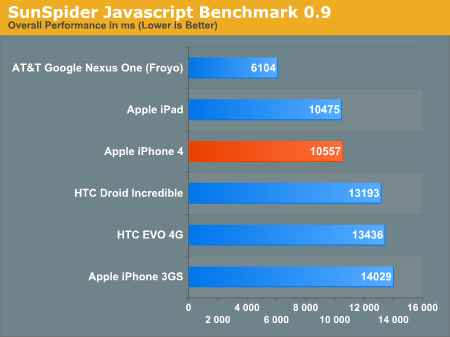
The iPhone 4 manages a time that’s 25% faster. Note that this test is just as much about the software stack as it is about CPU/platform performance. The Froyo update makes the Nexus One ridiculously fast in this benchmark. It just shows you how much room there is to improve performance on these Android handsets. The next leapfrog is going to be once the entire Android world moves to 2.2.
Next up is the Rightware BrowserMark. This test combines JavaScript and HTML rendering performance:
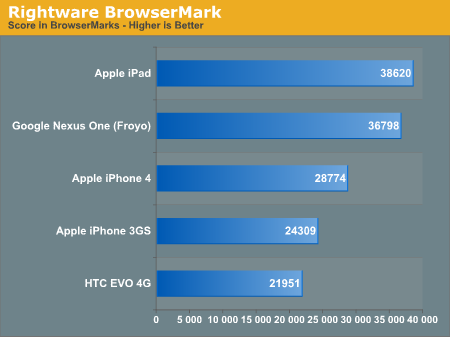
BrowserMark spits out an overall score but with no indication of what the score actually means. In this case we’re looking at 18.4% better performance than the iPhone 3GS. The iPad is 34% faster than the 4, which supports the theory of the A4 running at ~750MHz in the new iPhone.
There's also the possibility that the A4 CPU clock varies depending on load and other factors but the run to run consistency in all of our tests seems to indicate otherwise. We also can't ignore the fact that the iPad and iPhone now run vastly different OS revisions. In some cases iOS 4 actually takes a step back in performance compared to iOS 3.2. That undoubtedly makes the iPad vs. iPhone 4 comparison about much more than CPU performance.
Froyo's improved Javascript performance sends the Nexus One nearly to the top of the list here, only bested by the iPad. While Apple has definitely improved performance with the iPhone 4, it seems that it will only take a software update for Android phones to surpass it.
To measure web browsing performance I downloaded a bunch of different web pages and saved as much of them as possible locally on a server. I used WiFi on all of the devices to connect to my local server and timed average load time. I repeated the test at least 3 times and threw out any unusually high or low numbers. Performance was from a clean restart with no additional programs running in memory.
Note that these numbers aren't comparable to other reviews as we've updated software versions on two of the phones. The iPhone 3GS is now running iOS 4 which resulted in some numbers going up while others went down. And the Google Nexus One is running the officially released build of Android 2.2, codenamed Froyo.
What these tests should show is the overall performance of the platform when all network bottlenecks are removed. Obviously hiding in a tunnel under a lead umbrella will make any phone slow, but we’re looking at peak performance here.
The first test is the new AnandTech front page. Here we’ve got tons of images and HTML, meaning we’re stressing both bandwidth and code parsing speed.
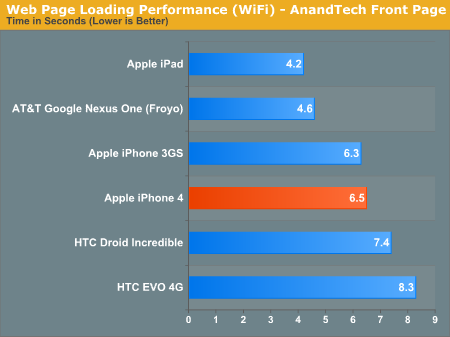
The iPhone 4 is no faster than the 3GS (actually slightly slower, but we'll chalk that up to timing variance) here. The Froyo update to the Nexus One makes it lightning quick, almost as fast as the iPad in our first test.
Next up we have the first page of our recent Zotac XBOX HD-ID11 review. The balance shifts from tons of images to more HTML processing:
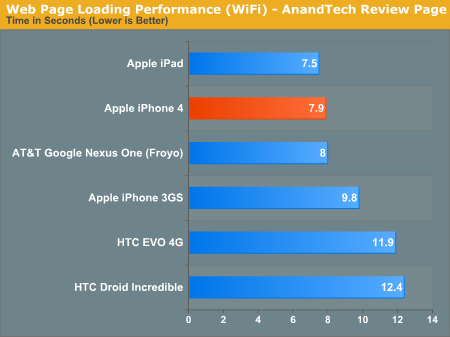
Here we see more of what I expected: the iPhone 4 is around 25% faster than the 3GS running iOS 4. Android 2.2 running on the Nexus One is basically as fast as the 4.
Using our Print this Review function, this next test loads our entire 2010 15-inch Macbook Pro review. While the other two tests had some flash ad content, this one is completely devoid of it so the HTC phones shouldn’t be penalized:
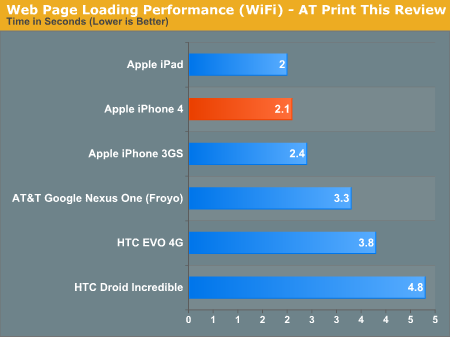
Here the iPhone 4 is 11% faster than the 3GS and about the speed of the iPad. There are other bottlenecks at play here so we don't get further performance scaling. The Froyo update helps the Nexus One a bit but the iOS devices are still quicker.
Our most intensive test is up next with a load of the Engadget front page:

The Nexus One is ahead of the 4 once more with its Froyo update. And the iPhone 4 is 34% faster than the 3GS.
Our most CPU bound test is up next. I put together a custom page with a ton of tabular content and a single page copy of our 15-inch MBP review to make the load take some time at least.
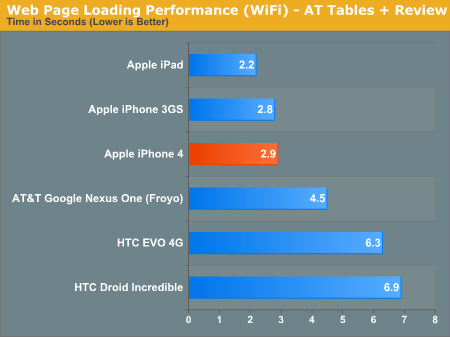
Surprisingly enough there's no difference between the 3GS and the 4 here, perhaps my test is less CPU bound than I thought. Froyo improves the Nexus One's performance a little bit.
Low Level Synthetic Tests
If we assume that we’re mostly CPU bound in all of these cases (a fair assumption given how fast Atom can run through all of these tests), then we’d be looking at a ~750MHz clock speed for the iPhone 4’s A4 assuming no other architectural changes. That’s actually a pretty big assumption. The A4 is widely believed to be a 45nm SoC using an ARM Cortex A8. At 45nm there should be room for a larger L2 cache than what was used in the iPhone 3GS’s SoC.
Perhaps some more synthetic tests will help us figure out what’s going on. I turned to Geekbench, now available in an iOS version.
Geekbench spit out a number of overall results that gave me a good enough summary of what’s going on to make an educated guess:
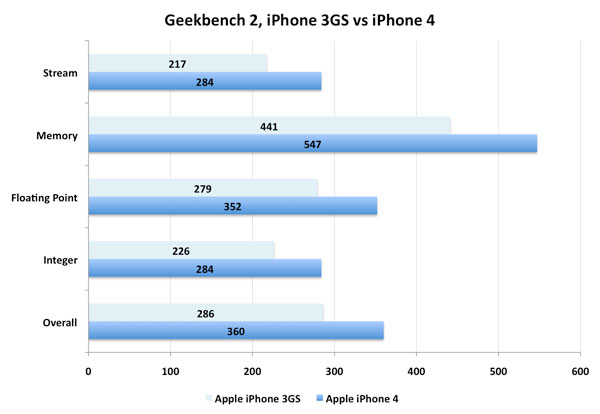
The CPU specific tests all indicate the iPhone 4 is around 25% faster than the iPhone 3GS. That would imply at least a 750MHz clock speed if all else is the same. Assuming we don’t get perfect CPU scaling with all of these tests, I’d venture a guess that 800MHz is more accurate. If the A4 does indeed have larger caches however, Apple could get away with a lower clock speed.
The memory results are particularly telling as they all scale very well going to the iPhone 4, better than the CPU results in fact. This could lend credibility to the theory of larger internal caches or perhaps to an improved (faster) memory subsystem.
Unfortunately until we get the iPad on iOS 4 we can't get a better idea of CPU scaling. I'm not even sure how reliable that will be at this point. If Apple was willing to change the amount of memory the A4 package housed between the iPad and iPhone 4, who is to say that it wouldn't have a slightly different design for the iPhone 4 (e.g. larger caches). The designs may not be physically different but we may instead be looking at binning. Given Apple's unwillingness to talk about the architecture here I think the safest bet is that we're looking at an 800MHz ARM Cortex A8 core in the iPhone 4 and a 1GHz core in the iPad.
Why the lower clock? It's all about battery life.










270 Comments
View All Comments
metalev - Saturday, July 3, 2010 - link
I ploted the signal-strength-to-bars mapping for both Android and the iPhone 4 on the same axes:http://www.metalev.org/2010/07/android-vs-iphone-4...
This shows that the iPhone 4 consistently reports a higher percentage signal strength (as defined by the fraction of bars lit) than Android GSM devices at the same signal strength.
R. Johnson - Saturday, July 3, 2010 - link
I don't understand how Apple (Iphone4) can say the antenna issue is a math problem when I can sit here with all full antenna bars and then hold the phone with my left hand and get only half a bar within 15 seconds. I don't know what to trust anymore when Apple decides to use different math and different bars in an upcoming update. I am afraid they may now use different bars to have it APPEAR there is better reception than there really is.R. Johnson
SunSamurai - Saturday, July 3, 2010 - link
You better hurry and put on the tinfoil hat too.Give me a break. The article already pointed out it was a simple error in how the bars were representing signal. The actual numerical signal is actually better. They basically did the opposite of what youre freak'n out about.
navderek - Saturday, July 3, 2010 - link
@SunSamuraiPlenty of reason to freak out. This is a very obvious design flaw that has been overlooked by Apple, and now denied by Apple. I am an RF Engineer and when I watched the Apple keynote presentation of the device I almost fell off my chair when he presented the antenna design...Then I thought, no it must have a light coat of something to shield the antenna....guess not.
Apple is making profit hand over fist and paying sweatshop workers pennies to put these things together...the least they could do is provide free bumpers. No they won't though because they will open the door to legal issues...who cares, they can afford the legal costs and it would save their face and allow them to continue unscathed...Now they just look like any other greedy company out there. They've really lost there magic IMO. It's discouraging that profits > honor. They are a real good company and this will really hurt them.
StormyParis - Saturday, July 3, 2010 - link
The article is very nice, but the conclusion lets us down and not gently by falling into the fanboi worldview. I'm neither an Apple nor Android nor Palm fanboi. I recently bought an HD2, and I'm definitely NOT an MS fanboi. I just wanted the biggest possible screen, and the HD2's is 40% bigger than the iPhone's... it's not about resolution, but size: I'm getting old.If the Dell Streak had been out in my country, I'd probably have gotten it instead. If palm had a big-screen, keyboardless phone, I'd have strongly considered it, seeing that right before the HD2, I was still using my Palm TX because it just works.
Right now I wouldn't consider Apple because it's too closed, and too cumbersome to get content onto (iTunes crapped out on my PC every time I tried it). I'm not sure I could get winhttrack'ed sites onto it.
I think most phones have reached the point of "good enough". On mine, I'm using a browser, an ebook reader, a media player... and that's about it. I don't game, I don't do social web things, I don't need a fashion accessory/personality crutch...
SunSamurai - Saturday, July 3, 2010 - link
You sound bitter. Tell us where the iphone/droid touched you.btharms - Saturday, July 3, 2010 - link
My phone drops from 5 bars to 1 bar frequently. The way I comfortably hold the phone covers the black strip more often than not. I have run speed test after speed test, and what I have found is that while covering the strip, my 3g connection will drop to 0kbps! I can literaaly freeze safari while loading any web page by temporarily placing my finger on the black strip (it will continue to load a second or two after I remove my finger).I was achieving download speeds of around 1600 kilobits/sec with the phone in my hand without covering the black strip. When redoing the test while holding the phone normally (with my pinky finger covering the strip) the speed dropped as low as 0 (100 kilobits per second was the fastest). Actually, many times the test would not start until I removed my pinky from the spot. Then, after the test began I would softly place my pinky back on the strip - and instantly the speed drops near 0.
So as thorough as your testing was, realizing that the phone misrepresents signal strength is really not a pertinent issue when you consider that the 3g signal virtually dissapears immediately on contact with the black strip.
I'm basically demanding that apple comps me a free bumper or i'm returning my phone.
navderek - Saturday, July 3, 2010 - link
The main point is that by Apple redoing the math on the signal bars...it will have no effect on the issues your seeing. Bars don't man a thing. Real life means everything and if the call drops with 5 bars or zero bars it does not matter - the call still drops!THIS IS JUST A STUNT BY APPLE TO PUT THE BLAME ON THE CARRIERS...OPEN YOUR EYES PEOPLE. Once the SW update happens then people will go back to complaining about AT&T and others...just like Apple wants it.
Thing is, poeple aren't as dumb as Apple thinks. But I guess this is the most financially obvious thing for Apple to do. Shift the blame, it's not our problem!
Mike Wadner - Saturday, July 3, 2010 - link
I started reading your review and stopped immediately upon seeing this statement: Apple has real competitors in the smartphone space. Android phones have grown in features, polish and popularity. Even Palm entered the race with a competant offering, and Microsoft isn't far behind.What cave have you been in for the last year? Do you not have a F**KING clue what Microsoft just did with their phone this week - THEY ARE MILES BEHIND EVERYONE IN HARDWARE AND SOFTWARE. My 13 year old kid wouldn't even make a statement this stupid.
Microsoft is stillborn when it comes to mobile. To even consider Microsoft a worthy competitor in the smart phone area is insane.
You're credibility just went down the crapper with that statement.
navderek - Saturday, July 3, 2010 - link
Agreed...the review may be good to the laymen, but for others not so much. I highly respect Anandtech's reviews but this is really the first one I've seen where they seem to have done the review just to get some of that Apple limelight without actually asking the tough questions like why Apple went and designed the antenna like this? What is the link between this poor antenna design and the sudden sale of bumpers by Apple? hmmmmmm